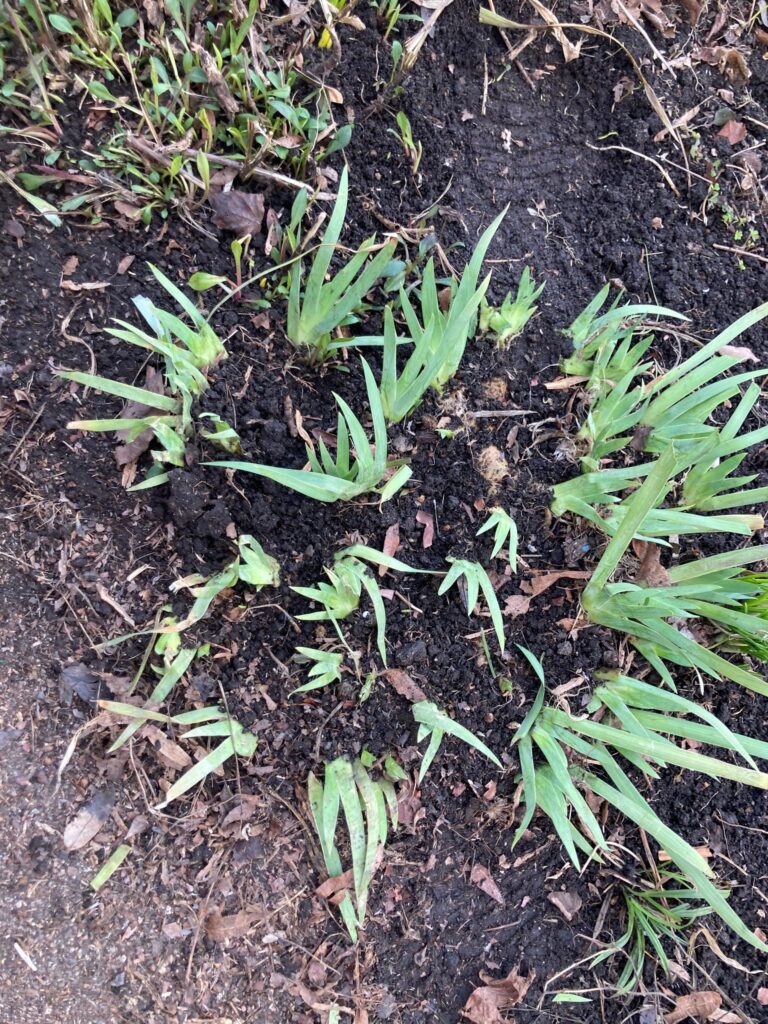Yesterday, I uncovered and cleaned up my irises. Irises were my favorite flower as a kid, mostly because I had a paper craft kit that let you make various flowers, and the irises, with their complex structure, were both tricky to do and very satisfying to complete. So when we bought our house, I knew I wanted to plant irises as soon as possible.
The first year was very frustrating, though. I’d ordered 2-3 varieties of bearded irises, dutifully planted them when they arrived, and waited with bated breath for my gorgeous blooms. A whole year went by — nothing! I was ready to write indignantly to the nursery and complain, but I did a little research, and learned that irises often don’t bloom the first year. So there wasn’t necessarily anything wrong with the plants; they just take a little while to get going.
Patience has never been my strong suit; maybe that’s part of why I love gardening, because it forces me to slow down a little. In the second year, my irises (I went for shades of blue and purple and magenta and almost-black) bloomed gorgeously; I was rewarded. (Try “Batik” — it’s fabulous. Photo 5, in front.)
I added more, one or two more each year, including a few Siberian irises, which have the benefit of lots of blooms and tall thin sword-like leaves that look good for months on end. Deep blue “Caesar’s Brother” and white “Gull’s Wing” are favorites of mine. (photos 3 & 4).
A few years later, though, I noticed that my irises were blooming less than they had been. Very sad! By that time, I’d learned to research before panicking, and a little googling quickly taught me that irises need to be divided every 3-5 years, if you want them to keep blooming well. Otherwise, they get quiet and sleepy, and you might get a flower here and there, but nothing like the flush of youthful exuberance they’d had before.
Luckily, they’re easy to divide. When you’re uncovering your garden in the spring, older irises will have started heaving themselves up out of the ground, their tubers swollen and protuberant. (photo 1) They tend to have fewer leaves, in my experience, than the young irises. If the young irises have some withered yellow-white leaves lingering, you can safely remove them; they’ll generally just pull off easily, and if not, a quick clip will take care of it. If some of those older leaves look all right, but are withered at the ends, you can just clip off the withered bit with an angled cut, and they’ll look a little nicer. (photo 2)
But the older irises are your treasures — dig them up entirely, and then divide them. They should break easily in your hands into separate tubers — try to keep a bit of fresh green leaf on each one. How many pieces you get will mostly depend on how long you’ve let them go before dividing.
That’s it — just replant them within a day or two, watering them in well, and within a year or two, you should have more irises to delight in. (For Siberian irises, that are more grass-like, dig them up, divide into clumps of three, and re-plant.)
And if you don’t have room for more irises in your garden, your neighbors will be very happy to take them off your hands. Perennial gardens make it easy to be generous. If you don’t feel like doing the division yourself, someone will probably be happy to come dig and divide for you, if they get to take away some irises when they’re done.
Note — bearded irises bloom at the same time as pollinator-friendly native baptisia, and look lovely together, so you may want to plan for that. (Blooming photos are from last year, around mid-May.)
And if that’s not enough irises for you, consider planting some reticulated irises, which bloom in March / April, with the other spring ephemerals. They are tiny and adorable, and once planted, need no care at all. “Katharine Hodgkin” is a pale, delicate blue that always gets compliments and questions from neighbors walking by.





